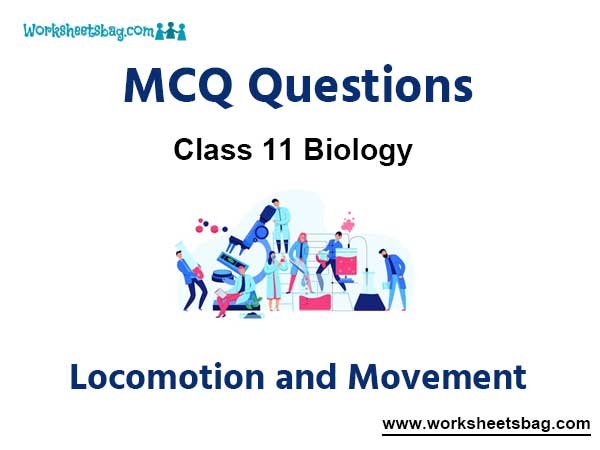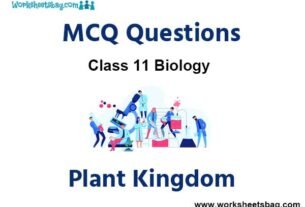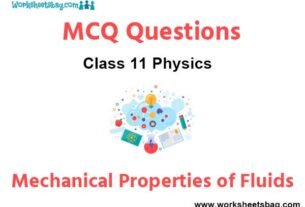Please refer to Locomotion and Movement MCQ Questions Class 11 Biology below. These MCQ questions for Class 11 Biology with answers have been designed as per the latest NCERT, CBSE books, and syllabus issued for the current academic year. These objective questions for Locomotion and Movement will help you to prepare for the exams and get more marks.
Locomotion and Movement MCQ Questions Class 11 Biology
Please see solved MCQ Questions for Locomotion and Movement in Class 11 Biology. All questions and answers have been prepared by expert faculty of standard 11 based on the latest examination guidelines.
MCQ Questions Class 11 Biology Locomotion and Movement
Question- Myasthenia is an _____ disorder affecting neuromuscular junction leading to fatigue, weakening and paralysis of skeletal muscles
(a) Arthritis
(b) Autoimmune
(c) Agnosic
(d) Amnesic
Answer
B
Question- Progressive degeneration of skeletal muscle due to genetic disorder is called
(a) Myasthenia gravis
(b) Tetany
(c) Muscular dystrophy
(d) Myopia
Answer
C
Question- Joints have been classified into three major structural forms as follows except
(a) Bony
(b) Fibrous
(c) Cartilaginous
(d) Synovial
Answer
A
Question- Which of the following is not a bone of cranium?
(a) Occipital bone
(b) Zygomatic bone
(c) ethmoid bone
(d) Sphenoid bone
Answer
B
Question- During muscle contraction.
(a) chemical energy is changed to electrical energy.
(b) mechanical energy is changed to chemical energy.
(c) chemical energy is changed to physical energy.
(d) chemical energy is changed to mechanical energy.
Answer
A
Question- Smooth muscle is
(a) found in walls of heart only.
(b) found in the walls of all the hollow organs except heart.
(c) attached to the bones only.
(d) found only in the walls of alimentary canal.
Answer
B
Question- A cup shaped cavity for articulation of femur head is
(a) acetabulum
(b) glenoid cavity
(c) sigmoid notch
(d) obturator foramen
Answer
A
Question- Which of the following statement is correct?
(a) All striated muscles are voluntary.
(b) Visceral muscles are faintly striated.
(c) Cardiac muscles are not striated.
(d) All non-striated muscles are involuntary.
Answer
D
Question- During fatigue
(a) muscles cannot relax.
(b) muscles fail to be stimulated.
(c) blood supply to muscles stops.
(d) nerve supply to muscles become inactive.
Answer
B
Question- Actin protein occurs in which of the following two forms ?
(a) Polymeric F- actin and monomeric G- actin
(b) Monomeric F- actin and polymeric G-actin
(c) The tail and a head
(d) F-actin and G- actin, but both globular.
Answer
A
Question- Function of long bones in adult mammals is to provide
(a) support only.
(b) support and produce RBCs only.
(c) support and produce WBCs only.
(d) support and produce RBCs and WBCs.
Answer
A
Question- Anisotropic band is
(a) thick and dark
(b) thin and dark
(c) thick and light
(d) thin and light
Answer
A
Question-Troponin
(a) produces sliding movement of microtubules
(b) contains globular head
(c) binding to Ca+2 produces skeletal muscle contraction.
(d) covers the active site of actin.
Answer
D
Question- Which of the following is not part of axial skeleton?
(a) Sacrum
(b) Sternum
(c) Mandible
(d) Humerus
Answer
D
Question- A sarcomere is best described as a
(a) movable structural unit within a myofibril bounded by H zones.
(b) fixed structural unit within a myofibril bounded by Z lines.
(c) fixed structural unit within a myofibril bounded by A bands.
(d) movable structural unit within a myofibril bounded by Z lines.
Answer
D
Question- An example of gliding joint is
(a) humerus and glenoid cavity
(b) femur and tibio-fibula
(c) occipital condyle and odontoid process
(d) zygapophyses of adjacent vertebrae
Answer
D
Question- During resting stage the binding site of actin for myosin remains masked by
(a) troponin
(b) G-actin
(c) tropomyosin
(d) meromyosin
Answer
A
Question- Number of floating ribs in human body is
(a) two pairs
(b) three pairs
(c) five pairs
(d) six pairs
Answer
A
Question- Red muscle fibres are rich in
(a) golgi bodies
(b) mitochondria
(c) lysosomes
(d) ribosomes
Answer
B
Question- The axon terminals of a nerve cell and the sarcolemma of a skeletal muscle cell join at the_______
(a) motor unit
(b) synaptic cleft
(c) action potential
(d) neuromuscular junction
Answer
D
Question- In mammals the lower jaw is made of
(a) maxilla
(b) dentary
(c) mandible
(d) ethmoid
Answer
C
Question- Which muscle protein acts as ATPase?
(a) Actin
(b) Troponin
(c) Myosin
(d) Tropomyosin
Answer
C
Question- Which of the following is a single U shaped bone, present at the base of the buccal cavity and it is also included in the skull?
(a) Hyoid
(b) Malleus
(c) Sacrum
(d) Scapula
Answer
A
Question- The vertebral formula of human adult is
(a) C7T12L5S5Cd1
(b) C7T12L 5S5Cd5
(c) C7T12L5S5Cd4
(d) C7T12L5S4Cd4
Answer
C
Question- During muscle contraction in humans the
(a) actin filaments shorten.
(b) sarcomere does not shorten.
(c) A-band remain same.
(d) A, H and I bands shorten.
Answer
C
Question- Striations in the striated muscles are due to
(a) absence of myofilaments.
(b) presence of myofilaments.
(c) specialized arrangement of myofilaments.
(d) projections of myosin.
Answer
C
Question- Glenoid cavity is found in
(a) pelvic girdle
(b) skull
(c) pectoral girdle
(d) sternum
Answer
C
Question- Which set clearly identify striated muscles?
(a) Cylindrical, Syncytial and Unbranched
(b) Spindle, Unbranched and Uninucleated
(c) Cylindrical, Striped and Nucleated
(d) Cylindrical, Striped and Branched
Answer
A
Question- Which of the following is an autoimmune disorder ?
(a) Myasthenia gravis
(b) Osteoporosis
(c) Muscular dystrophy
(d) Gout
Answer
A
Question- Elbow joint is an example of
(a) hinge joint
(b) gliding joint
(c) ball and socket joint
(d) pivot joint
Answer
A
Question- What is not true about human skull?
(a) It is dicondylic.
(b) It includes 6 ear ossicles.
(c) It includes 14 facial bones.
(d) Hyoid is not included in skull bones.
Answer
D
Question- Striated muscle fibres are found in
(a) urinary bladder
(b) lungs
(c) gall bladder
(d) leg muscles
Answer
D
Question- Which of the following is the store house of calcium in muscles?
(a) Sarcosome
(b) Sarcoplasmic reticulum
(c) Creatine phosphate
(d) Sarcomere
Answer
B
Question- Identify the joint between sternum and the ribs in humans.
(a) Fibrous joint
(b) Gliding joint
(c) Cartilaginous joint
(d) Angular joint
Answer
C
Question- Part of the body having a single pair of bones is called
(a) pelvic girdle
(b) external ear
(c) wrist
(d) lower jaw
Answer
A
Question- The joint in our neck which allows us to rotate our head left to right is
(a) pivot joint
(b) hinge joint
(c) saddle joint
(d) ellipsoid joint
Answer
A
Question- Cardiac muscles are different from that of skeletal muscles as the former are
(a) striated but involuntary.
(b) non striated and involuntary.
(c) smooth or unstriated.
(d) voluntary in action.
Answer
A
Question- Accumulation of uric acid crystals in the synovial joint causes
(a) rheumatoidal arthritis
(b) gout
(c) osteoarthritis
(d) muscular dystrophy
Answer
B
Question- Read the following 4-statements (i – iv) and accordingly mark the option that has both correct statements.
(i) Cardiac fibres are branched with one or more nuclei.
(ii) Smooth muscles are unbranched and cylindrical.
(iii) Striated muscles can be branched or unbranched.
(iv) Involuntary muscles are non-striated.
(a) (i) and (iv)
(b) (ii) and (iii)
(c) (iii) and (iv)
(d) (i) and (iii)
Answer
D
Question- Hyoid bone is located
(a) at the top of the buccal cavity.
(b) at the floor of the buccal cavity.
(c) in front of the skull.
(d) behind the skull.
Answer
B
Question- Which of the following statement is incorrect ?
(a) All movements lead to locomotion.
(b) Ciliary movement help in passage of ova through female reproductive tract.
(c) Microfilaments are involved in amoeboid movement.
(d) In Paramecium, the cilia help in movement of food through cytopharynx and in locomotion as well.
Answer
A
Question- Which of the following statements is/are correct?
(i) During muscle contraction, isotropic band gets elongated.
(ii). Acetylcholine is released when the neural signal reaches the motor end plate.
(iii) Muscle contraction is initiated by the signal sent by CNS via a sensory neuron.
(iv) Repeated activation of muscle can lead to lactic acid accumulation.
(a) (i) and (iii)
(b) (ii) and (iv)
(c) (i), (ii) and (iii)
(d) (ii), (iii) and (iv)
Answer
B
Question- Which of the following is not the feature of red muscle fibres?
(a) They have plenty of mitochondria.
(b) They have high content of myoglobin.
(c) They have high amount of sarcoplasmic reticulum.
(d) They are called aerobic muscles.
Answer
C
Question- Read the following statements (A to D) and select the one option that contains both correct statements.
A. Z-line is present in the centre of the light band.
B. Thin filaments are firmly attached to the M-line.
C. The central part of thick filaments, not overlapped by thin filaments is called Z-band.
D. Light band contains only thin filaments.
(a) A and D
(b) B and C
(c) A and C
(d) B and D
Answer
A
Question- A-band of the myofibril contains
(a) only thick filaments
(b) only thin filaments
(c) both thick and thin filaments
(d) no filaments
Answer
C
Question- Contractile tissues have the following features.
(i) They are mesodermal in origin.
(ii) They contain stretch receptors.
(iii) Rhythmic contractions are seen in them.
(iv) They do not fatigue during the life of the animal.
Which of the above are characteristics of sphincters?
(a) Only (i), (iii) and (iv)
(b) Only (i), (ii) and (iii)
(c) Only (i), (ii) and (iv)
(d) All of these
Answer
B
Question- The macrophages in human body exhibit
(a) ciliary movement
(b) amoeboid movement
(c) no movement
(d) movement with the blood flow only
Answer
B
Question- Which one of the following is the correct description of certain part of a normal human skeleton?
(a) Parietal bone and the temporal bone of the skull are joined by fibrous joint.
(b) First vertebra is axis which articulates with the occipital condyles.
(c) The 9th and 10th pairs of ribs are called the floating ribs.
(d) Glenoid cavity is a depression to which the thigh bone articulates.
Answer
A
Question- Select the correct statement regarding the specific disorder of muscular or skeletal system.
(a) Myasthenia gravis – Autoimmune disorder which inhibits sliding of myosin filaments.
(b) Gout – Inflammation of joints due to extra deposition of calcium.
(c) Muscular dystrophy – Age related shortening of muscles.
(d) Osteoporosis – Decrease in bone mass and higher chances of fractures with advancing age.
Answer
D
Question- Select the correct statement with respect to locomotion in humans.
(a) Accumulation of uric acid crystals in joints causes their inflammation.
(b) The vertebral column has 10 thoracic vertebrae.
(c) The joint between adjacent vertebrae is a fibrous joint.
(d) The decreased level of progesterone causes osteoporosis in old people.
Answer
A
Question- Which of the following vertebrae are fused?
(a) Cervical
(b) Sacral
(c) Lumber
(d) Thoracic
Answer
B
Question- According to the sliding filament theory of muscle contraction,
(a) actin binds ATP and breaks it apart as actin pulls against myosin.
(b) calcium ions are released from myosin as the filaments slide by.
(c) the thick and thin filaments do not change length during this process.
(d) all of the above
Answer
C
Question- In humans, coccyx is formed by the fusion of
(a) 3 vertebra
(b) 4 vertebra
(c) 5 vertebra
(d) 6 vertebra
Answer
B
Question- Three of the following pairs of the human skeletal parts are correctly matched with their respective inclusive skeletal category and one pair is not matched. Identify the non-matching pair.
Pairs of skeletal parts Category
(a) Sternum and ribs – Axial skeleton
(b) Clavicle and glenoid – Pelvic girdle cavity
(c) Humerus and ulna – Appendicular skeleton
(d) Malleus and stapes – Ear ossicles
Answer
B
Question- Which of the following pair shows the correct characteristics with an example of a synovial joint in humans?
Characteristics Examples
(a) Fluid filled between – Skull bones two joints, provides cushion
(b) Fluid filled synovial – Joint between cavity between two atlas and axis bones
(c) Lymph filled between – Gliding joint two bones, limited between movement carpals
(d) Fluid cartilage – Knee joint between two bones, limited movements
Answer
B


